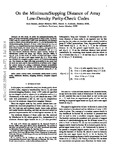On the Minimum/Stopping Distance of Array Low-Density Parity-Check Codes
| dc.contributor.author | Rosnes, E | |
| dc.contributor.author | Ambroze, Marcel | |
| dc.contributor.author | Tomlinson, M | |
| dc.date.accessioned | 2020-08-21T10:21:59Z | |
| dc.date.available | 2020-08-21T10:21:59Z | |
| dc.date.issued | 2014-07-11 | |
| dc.identifier.issn | 0018-9448 | |
| dc.identifier.issn | 1557-9654 | |
| dc.identifier.other | 0 | |
| dc.identifier.uri | http://hdl.handle.net/10026.1/16179 | |
| dc.description | To appear in IEEE Trans. Inf. Theory. The material in this paper was presented in part at the 2014 IEEE International Symposium on Information Theory, Honolulu, HI, June/July 2014 | |
| dc.description.abstract |
In this work, we study the minimum/stopping distance of array low-density parity-check (LDPC) codes. An array LDPC code is a quasi-cyclic LDPC code specified by two integers q and m, where q is an odd prime and m <= q. In the literature, the minimum/stopping distance of these codes (denoted by d(q,m) and h(q,m), resp.) has been thoroughly studied for m <= 5. Both exact results, for small values of q and m, and general (i.e., independent of q) bounds have been established. For m=6, the best known minimum distance upper bound, derived by Mittelholzer (IEEE Int. Symp. Inf. Theory, Jun./Jul. 2002), is d(q,6) <= 32. In this work, we derive an improved upper bound of d(q,6) <= 20 and a new upper bound d(q,7) <= 24 by using a new concept of a template support matrix of a codeword/stopping set. The bounds are tight with high probability in the sense that we have not been able to find codewords of strictly lower weight for several values of q using a minimum distance probabilistic algorithm. Finally, we provide new specific minimum/stopping distance results for m <= 7 and low-to-moderate values of q <= 79. | |
| dc.format.extent | 5204-5214 | |
| dc.language.iso | en | |
| dc.publisher | Institute of Electrical and Electronics Engineers (IEEE) | |
| dc.subject | Array codes | |
| dc.subject | low-density parity-check (LDPC) codes | |
| dc.subject | minimum distance | |
| dc.subject | stopping distance | |
| dc.subject | template support matrix | |
| dc.title | On the Minimum/Stopping Distance of Array Low-Density Parity-Check Codes | |
| dc.type | journal-article | |
| dc.type | Article | |
| plymouth.author-url | https://www.webofscience.com/api/gateway?GWVersion=2&SrcApp=PARTNER_APP&SrcAuth=LinksAMR&KeyUT=WOS:000342415600009&DestLinkType=FullRecord&DestApp=ALL_WOS&UsrCustomerID=11bb513d99f797142bcfeffcc58ea008 | |
| plymouth.issue | 9 | |
| plymouth.volume | 60 | |
| plymouth.publisher-url | http://dx.doi.org/10.1109/TIT.2014.2333519 | |
| plymouth.publication-status | Published | |
| plymouth.journal | IEEE Transactions on Information Theory | |
| dc.identifier.doi | 10.1109/TIT.2014.2333519 | |
| plymouth.organisational-group | /Plymouth | |
| plymouth.organisational-group | /Plymouth/Faculty of Science and Engineering | |
| plymouth.organisational-group | /Plymouth/Faculty of Science and Engineering/School of Engineering, Computing and Mathematics | |
| plymouth.organisational-group | /Plymouth/REF 2021 Researchers by UoA | |
| plymouth.organisational-group | /Plymouth/REF 2021 Researchers by UoA/UoA12 Engineering | |
| plymouth.organisational-group | /Plymouth/Users by role | |
| plymouth.organisational-group | /Plymouth/Users by role/Academics | |
| dcterms.dateAccepted | 2014-04-01 | |
| dc.identifier.eissn | 1557-9654 | |
| dc.rights.embargoperiod | Not known | |
| rioxxterms.versionofrecord | 10.1109/TIT.2014.2333519 | |
| rioxxterms.licenseref.uri | http://www.rioxx.net/licenses/all-rights-reserved | |
| rioxxterms.licenseref.startdate | 2014-07-11 | |
| rioxxterms.type | Journal Article/Review |


